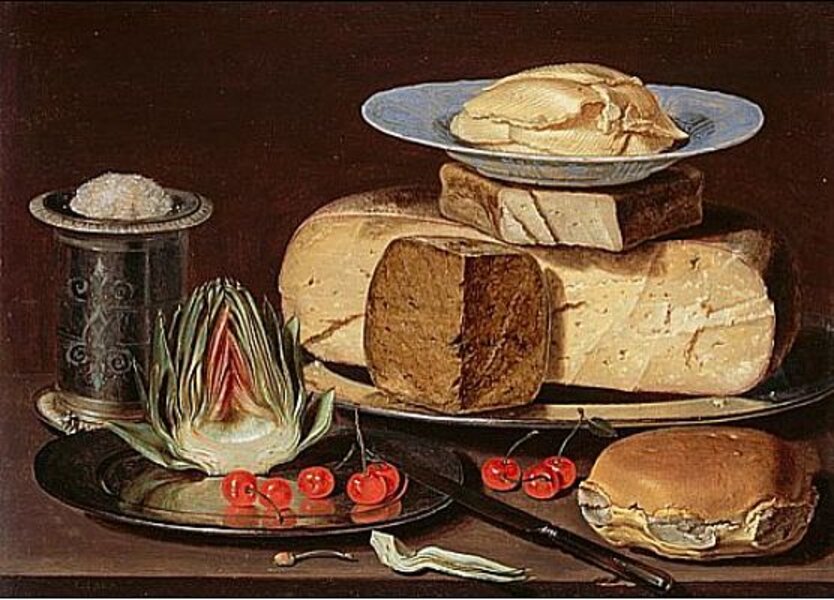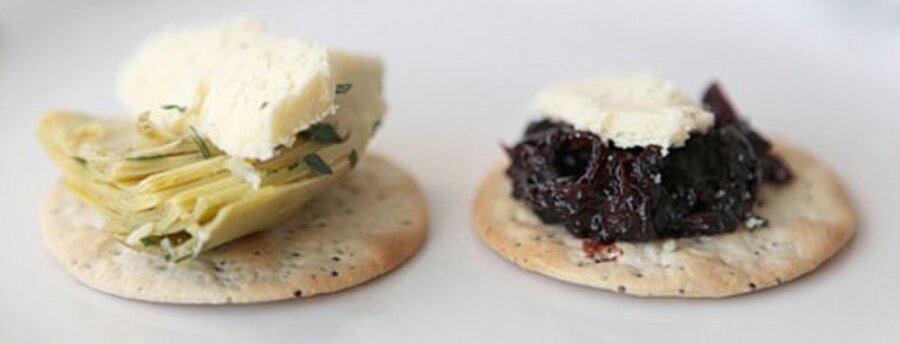Cheeseboard with marinated artichokes and spicy cherry chutney
Loading...
Cheese dates back to pre-recorded history, making it difficult to determine exactly where it was first developed. The word cheese is thought to be derived from the Latin caseus and in the Roman era, cheesemaking was already a widespread practice, with visual representations of the process even in the tombs of the Egyptians. The histories of specific types of cheese are more established as exemplified by the hard and sharp tasting cheddar. First made in Cheddar, Somerset, cheddar cheese dates back to the time of King Henry II and accounts for over half of all cheese consumption in the United Kingdom. The Italian mozzarella is a milky cheese made by heating curds that are stretched, kneaded and then cut. The semi-soft cheese, from the southern Italian regions, has high moisture content and is often consumed the day it is made. Similarly, cheese curds – the solids that form by souring milk, a common cheesemaking process – are best eaten within hours of production. Combining a selection of cheeses on a cheeseboard is best enjoyed with a helping of antipasti and spreads from pickled asparagus to onion marmalade as well as marinated artichokes and spicy cherry chutney, recipes below.
Clara Peeters, a Flemish artist working at the turn of the 17th century, painted meticulously detailed still life paintings influenced by Osias Beert. Her skill in rendering texture is evident in the rough and crumbly cheese and the smooth cherries. Her work is often thought to contain religious iconography and using the commonly associated symbolic meanings of the food depicted in Still Life with Cheeses, Artichoke and Cherries, the painting moves beyond a simple still life to a complex religious message.
The dominating forms of the cheese and butter shavings denoting motherhood are coupled with a bread roll that references the Eucharist. A trio of cherries reinforce the image of Christ via their iconographic meaning of the Passion. These items are gathered on the right side of the canvas, with a knife – often used to represent betrayal – dividing the composition and the food. The items on the left have negative connotations when contrasted with the icons of Christ and the Holy Mother on the right. The artichoke was considered an aphrodisiac and therefore could be linked with the sin of lust. The cherries on the left of the painting are in opposition to those on the right because they sit upon a mirrored plate. Mirrors were used to reference the sin vanity as well as lust (1). Salt was used to denote wisdom and appears to sit upon a scale – perhaps to suggest to the viewer to lead a balanced life in order to evade the perils of sin.
Marinated artichokes
1 can water-packed artichokes, drained
1/3 cup white wine vinegar
1 teaspoon lemon zest
1/2 clove garlic, minced
1/2 cup olive oil
1 teaspoon dried thyme
2 tablespoon fresh parsley, chopped
Mis the white wine vinegar, lemon zest and garlic in a small bowl. Add the drained and rinsed artichokes and toss in the vinegar mixture. Set aside for half an hour.
Once slightly pickled in the vinegar, add the rest of the ingredients and toss well, mixing the remaining vinegar and olive oil to create vinaigrette. Serve with other antipasti and cheese.
Spicy cherry chutney
adapted from Gourmet Magazine
1 orange peel
3 cups cherries
1 cup red onion, chopped
1 red chilli, chopped
1/4 cup balsamic vinegar
2 tablespoons cider vinegar
2 teaspoons fresh ginger, minced
1/2 teaspoon salt
1/2 teaspoon ground pink peppercorns
Carefully peel the orange and slice into thin julienned strips. In a large, heavy pot, stir together all of the ingredients. Bring to a boil and turn down to a simmer, stirring every couple of minutes. After about 35-40 minutes, stir more often and once the chutney has thickened, after 50 minutes, remove from the heat and let cool. Spoon into a jar and keep chilled for up to three weeks. Serve with cold meats or cheeses.
Megan Fizell deconstructs fine art in recipes at Feasting On Art.
--------------------------------------------------------------
The Christian Science Monitor has assembled a diverse group of the best food bloggers out there. Our guest bloggers are not employed or directed by The Monitor and the views expressed are the bloggers' own and they are responsible for the content of their blogs and their recipes. All readers are free to make ingredient substitutions to satisfy their dietary preferences. To contact us about a blogger, click here.






